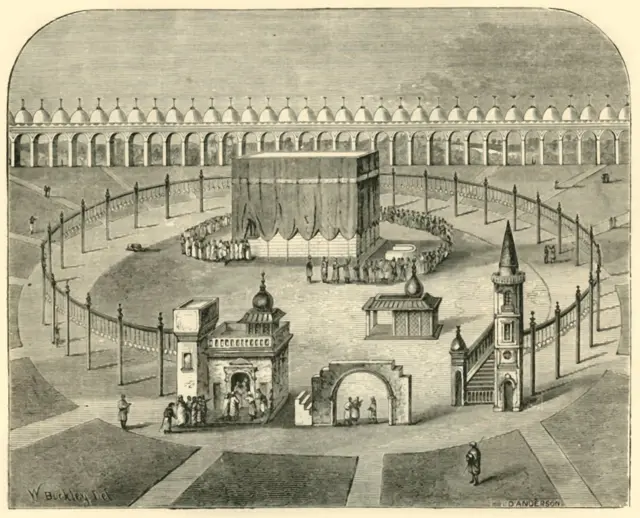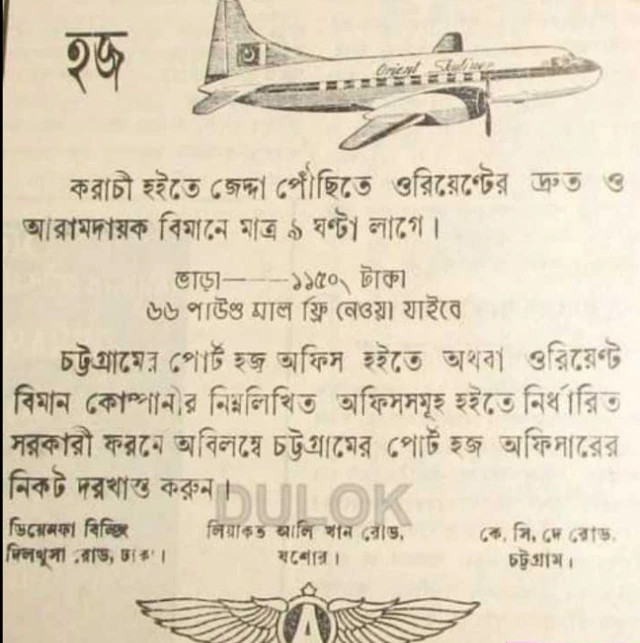About four and a half hundred years ago, on an autumn day, Mughal Shahzadi Gulbadan Begum started her journey to the holy cities of Mecca and Medina to perform Hajj.
Gulbadan Begum was leading a group of women pilgrims of the royal family. She was the first woman of the Mughal Empire in India to perform the Hajj.
Gulbadan Begum was the daughter of Emperor Babur, the founder of Mughal society. He was 54 years old when he went for Hajj.
The history of Hajj from the Indian subcontinent is older.
The history of Hajj from what is now Bangladesh dates back to the Sultanate period, which began in 1204. Muslim rule started in Bengal from that time.
According to historians, there is a history of transporting Hajj passengers from Chittagong Port by sailing ships since the Sultanate period.
A stormy sea voyage
The Hajj journey was initially quite difficult, and time-consuming.
Bahadur Khan Ahsanullah, a senior official of the education department of the then undivided Bengal and Assam, went to perform Hajj during the British rule.
He recorded the memory of Hajj in the book. He did not clearly mention the date on which he went for Hajj.
However, his writings suggest that the period of Hajj may be after 1920.
Khan Bahadur Ahsanullah wrote that he first went to Calcutta to perform Hajj. Then reach Allahabad from Kolkata.
Prepared to go to Mumbai (then Bombay) by train from Allahabad. Their intention was to board the Hajj ship from there.
But there was an outbreak of plague in Bombay. Therefore, instead of going to Mumbai, they went to Karachi port.
They had to wait a week for their ship to Karachi. Sea travel was as time-consuming as it was terrifying.
It is described in the book ‘Amar Jiban-Dhara’ written by Khan Bahadur Ahsan Ullah. They took rice, pulses, salt and other daily essentials with them on the ship. Because, they used to cook them themselves on the ship.
“A great wave arose in the sea. The ship tossed violently in the stormy waves. All the glassware in our room got smashed.”
“It was a dark, late night, with no one to meet. It was impossible to stand. I was waiting for death holding the ship’s chain on my knees, the passengers on the deck are vomiting on the bed, some are excreting in fear. It is a lifeless and poor scene! Every moment it seemed that the ship would sink into the sea,” wrote Mr. Ahsanullah.
It took him three months to travel by sea and complete Hajj.

IMAGE SOURCE,GETTY IMAGES
Haj journey starts from Chittagong port
After the division of the subcontinent in 1947 and the creation of India-Pakistan, Haj passenger transportation by sea was officially started through Chittagong port.
That is why a permanent Haji camp was established in Pahartali of Chittagong. All pilgrims of East Pakistan at that time used to travel through Chittagong Port for Hajj.
A few well-to-do Hajis used to fly from Dhaka to Karachi. Then they would start their journey towards Hajj from there.
Even during the late Pakistan era, two trips per ship were used to transport Haji from Chittagong to Jeddah. The first trip left seven days after Eid.
That is why pilgrims from East Pakistan used to go to Pahartali in Chittagong and stay in the camp after Eid. About 2,600 Hajj passengers were transported in two ships.
At that time there were two ships named Chafina-e-Arab and Chafina-e-Arafat.
At that time, advertisements were also advertised in newspapers to take Haj pilgrims by air from Karachi to Jeddah. One such advertisement of the then Orient Airways was shared by many people on Facebook at different times.
It was written in the advertisement – It takes only 9 hours to reach Jeddah from Karachi by Orient’s fast and comfortable flight. Rent 1150 Tk.
Ahmadul Islam Chowdhury, a writer on Islam and travel, wrote that this beautiful system was maintained at Chittagong port until 1970. At that time, the fare for deck and third class was Tk 1919. Out of this, Tk 1,000 is for accommodation and food in Saudi Arabia and Tk 919 is for food and fare on board and other government expenses. If you travel in the second class on the ship, the total cost would be 4 thousand 500 taka. Besides, the total cost in the first class was slightly more than seven thousand rupees.
Muhammad Ramzan of Karachi went to Hajj by ship in 1974. Mr. Ramadan gave an interview to Arab News in 2020.
“I purchased the ship ticket for Rs.6,000. Then he was on the ship for seven days and seven nights to reach Jeddah from Karachi,” said Mr. Ramadan.

Hajj after independence
After the independence of Bangladesh from Pakistan after nine months of war, a different situation emerged regarding Hajj.
Saudi Arabia did not recognize Bangladesh as an independent country, so Bangladeshis could not go for Hajj.
Pakistan’s diplomatic relations with Saudi Arabia were very deep. Saudi Arabia could not accept the fact that Bangladesh was established as a state after gaining independence from Pakistan.
As a result, immediately after independence, the then Bangladeshis had to go for Hajj with Indian passports.
Haj passengers are transported from Chittagong port by Indian Muhammadi ships. On the other hand, three thousand Hajj passengers were selected through lottery and sent by air from Dhaka.
The Indian ship was quite old and frail. As a result, it was not suitable for sea travel. Therefore, in 1977 Bangladesh government bought a ship, which was named ‘Hizbul Bahar’.
Hajj flights from Dhaka gradually increased and various administrative functions started here.

IMAGE SOURCE,EMBASSY OF BANGLADESH, RIYADH
Sheikh Mujib-Badshah Faisal meeting
In September 1972, the Saudi King sent a cable to Faisal. In that cable, Muslims of Bangladesh were invited to be allowed to perform Hajj. It was printed in various newspapers at that time.
“Most of the people of Bangladesh are devout Muslims and they strictly observe the precepts of Islam,” he said in the cable.
“If your government wishes to send any officer to grant visas, he will be welcomed and all facilities will be provided.”
In 1973, he joined the Non-Aligned Conference organized in the African country of Algeria.
Even then Pakistan and China as well as Saudi Arabia and Libya did not recognize Bangladesh. On reaching Algiers, Sheikh Mujibur Rahman expressed interest in meeting with Colonel Gaddafi and Saudi King Faisal.
Sheikh Mujib wants to know why Saudi Arabia and Libya are not recognizing Muslim majority Bangladesh.
But organizing this meeting was not very easy. Journalist (late) MR Akhtar Mukul wrote that this meeting was organized in Algiers with the tireless efforts of Sheikh Mujibur Rahman’s traveling companion Barrister Amirul Islam.

IMAGE SOURCE,GETTY IMAGES
Journalist M.R. Akhtar Mukul was among others who accompanied President Sheikh Mujibur Rahman.
In his book ‘Mujib’s Blood Red’ Mr. Mukul gave a detailed account of the meeting between Sheikh Mujibur Rahman and King Faisal.
But the meeting between Mujib and King Faisal was not fruitful. Sheikh Mujib wants to know why Saudi Arabia is not recognizing Bangladesh even though it is the second largest Muslim country after Indonesia. Because until Saudi Arabia recognized it, it was very difficult for the people of Bangladesh to go to Hajj.
For this, the Saudi king gave two conditions to Sheikh Mujib. One is – changing the name of Bangladesh to Islamic Republic of Bangladesh. And the other is – immediate release of all Pakistani prisoners of war.
But Sheikh Mujib could not agree on these matters.
“Since Saudi Arabia did not recognize the independent Bangladesh for almost two years, have you considered the fact that the pious Muslims there are not able to perform the holy Hajj?” Is it permissible to create obstacles in this way? Muslims from all over the world have the right to pray in the Holy Kaaba. Why are thousands of Bengali religious Muslims having to perform the Hajj on Indian passports today?” quoting Sheikh Mujib wrote Mr. bud
On the website of the Bangladesh Embassy in Riyadh, the capital of Saudi Arabia, it is written with a picture of Sheikh Mujibur Rahman and King Faisal that after this meeting, Bangladeshis were allowed to perform Hajj.